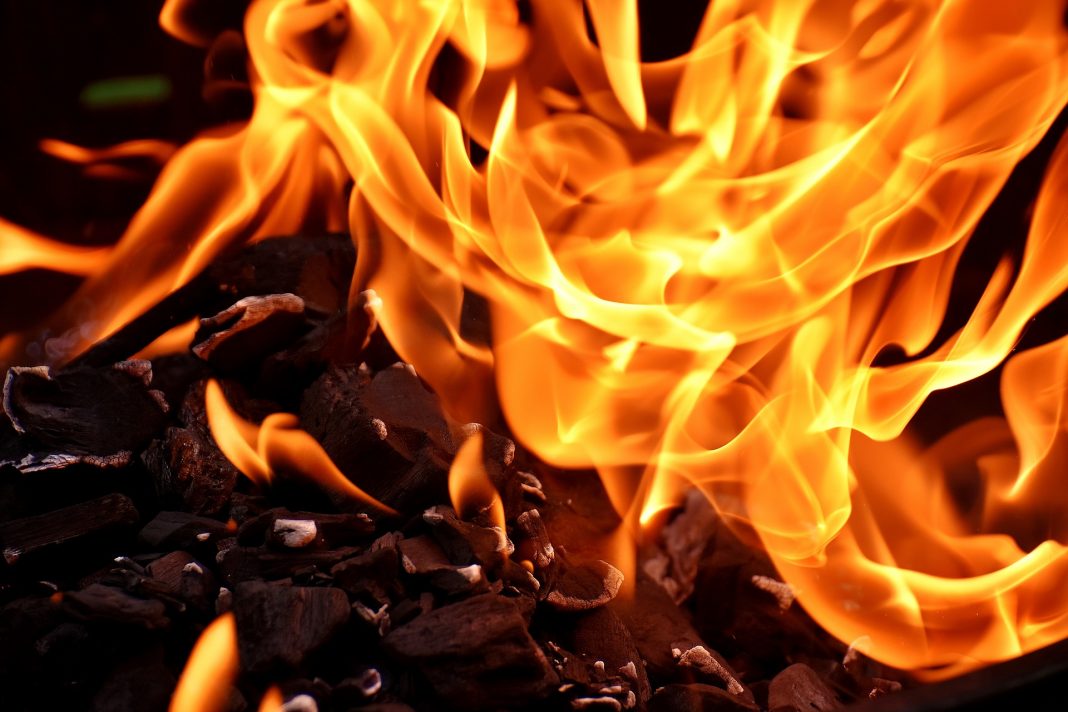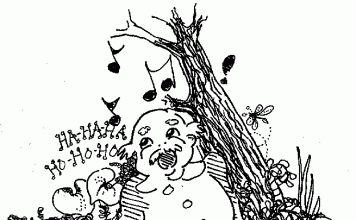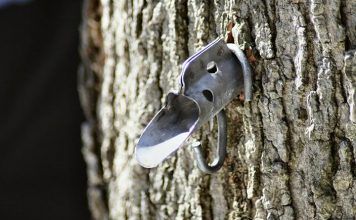| Issue #51 • May/June, 1998 |
Looking for a handy summer project while building skills, supplies, and knowledge to put away for a rainy future? Here’s one to consider: try making your own forge. The ability to forge scrap metal into useful tools is a skill that can bring self reliance and even extra income to any handy person willing to turn a hobby into a part time trade. Whether you’re just pounding out a simple project like a poker or hammering out custom knives, you’ll be building the tools and skills you’ll need to become more self reliant in the future.
 The portable forge, made from an old charcoal grill, fire brick, and iron pipe. The portable forge, made from an old charcoal grill, fire brick, and iron pipe. |
Building a small, portable hobby forge is not that difficult. This article will show you how to build one from a charcoal grill. Later, when you delve more deeply into blacksmithing, you can build yourself a full blown smithy.
Let’s start with what you’ll need. For my first forge, which I built six years ago, I started with an old portable 24-inch charcoal grill. Next, I bought myself some iron pipes and fixtures: one 18-inch pipe, two 6-inch pipes, one 8-inch pipe, two pipe caps, one elbow connector, and one T connector. All pipes and fixtures were 1-inch diameter, and all pipes were threaded on both ends.
Black or galvanized pipe?
Buy black pipe. If you buy galvanized pipe, you will have to let it “burn off” for a few hours before you can use it. “Burning off” is the process where, after you’ve completed your forge, you load it with charcoal (not storebought charcoal) and burn while forcing air through the pipes. During this process, approach the forge only to load coals, and come in with the wind. The zinc in the galvanized pipes is burning off at this time and will pose a hazard, as it is toxic.
Next, you’ll need 12 fire bricks.
 Figure A Figure A |
Here’s how to build your portable forge: Screw one end cap on one end of each of the 6-inch pipes. Next, using a drill press or hand drill with a one quarter inch drill bit, drill holes (not on the threads) on one side of a pipe. Start at the open end, drill a hole, then measure one half inch toward the opposite end and drill another hole. Repeat this process until you have a line of holes running between the threads, from one end of the pipe to the other end. Next, using the same drill bit, offset the pipe to the right one half inch, and drill between the existing holes, again from one end of the pipe to the other. Repeat this process one half inch to the left of the first holes drilled and you have finished the first pipe. Do the same thing with the other pipe. Check with Figure A for a visualization of the hole pattern. You do not have to drill all the way around the pipe, as you want the air to flow upward only, through the coals in the forge.
 Figure B Figure B |
Now take the T connector and, using the same drill bit, drill three holes (see Figure B) parallel with the threading one half inch apart and 3 quarters of an inch inward away from the threading. Complete this process on both sides of the T connector’s parallel connectors. Next, screw the 6-inch pipes into the T connector so that all the holes face the same way, as in Figure B. Now connect the 8-inch pipe into the stem of the T connector. That’s it; you’ve just built a tuyere, the part of the forge that channels air up through the coals.
 Figure C Figure C |
For the body of the forge, assemble the 24-inch diameter charcoal grill. You only need to connect the charcoal burner to the tripod. You don’t need the grill, and you can remove the center grill holder with a hack saw. Next, drill out the bottom center of the burner so that the one inch diameter pipe will fit through the hole. You can use a reamer and a hand drill for this job. When looking from the ground up, your hole must be directly in the center of the burner.
Next, before laying the bricks out in the burner, I like to spread ashes in the burner so that I have a flat surface in which to lay out the bricks. In place of ashes, sand will work fine.
Next, lay fire bricks, face side down, in accordance with Figure C. With your six remaining fire bricks you will make a rectangular box by laying the remaining bricks edge down on top of the face down bricks (see the photos). You’ve just completed the body of the forge.
Since you now have the tuyere and the body of the forge, you can simply put everything together by placing the tuyere’s 8-inch pipe down between the bricks through the bottom hole of the forge. Then screw the elbow connector to the tuyere’s open end, then to the 18-inch pipe. You now have the means to force air through your forge.
 Placement of the bottom bricks and tuyere Placement of the bottom bricks and tuyere |
As a blower to actually force air through the pipes, you can use a squirrel cage blower or bellows. For simplicity I use an old shop-vac with one end of its hose on the exhaust outport and the other end put over the open end of the 18-inch pipe. Make sure that the shop-vac’s hose is attached to the exhaust port. You want to force air up through the pipes, and through the coals. You do not want to suck smoke and hot coals down into the shop-vac.
I would like to point out here that I have not recommended that you lay the bricks permanently with mortar, or in this case refractory clay. This way you can remove the bricks and pipes for mobility.
Once you’ve connected the shop-vac or blower, you have completed the project, and you now own a forge, one of the central pieces of equipment that you’ll need for blacksmithing projects.
 Assembled forge with shop-vac Assembled forge with shop-vac |
Other pieces of equipment you’ll need are: an anvil, (which can be made from a length of railroad track or I-beam), a cross pein hammer, 2 or 3-pound sledge, a pair of tongs, a metal ash can to catch coals and hot embers as they fall through the bottom hole of the forge. Sooner or later, you’ll also want two metal cans that can accommodate hot metal of at least three feet in lengthone for water to cool iron and mild steel, and for emergencies, and the other for oil to quench and harden high carbon steel.
Making charcoal
Earlier in the article, I stated not to use store-bought charcoal (the kind most people cook out with). This is because store-bought charcoal contains impurities which can contaminate the steel or iron being worked, and can cause your project to become brittle. Fortunately, you can make your own contaminate-free charcoal.
Start by gathering some hardwood such as maple, oak, hickory. In many cases willow is preferred. I have had good results with all hardwoods. Saw the wood to adequate length (between the span and half the span of a hand). Chop to different thicknesses, but no thicker than is long. Next, you can either dig a fire pit or do as I do, which is use an old gas-burning grill with a lid with the gas components removed and the bottom lined with fire bricks. When I am sure the fire is burning adequately, I load the grill (or pit) with an abundance of hardwood and close the lid. In the case of the fire pit, cover with dirt, leaving one or more small openings to act as chimneys. Allow to burn for some time, 15 minutes to half an hour depending on the size of your pit/grill. Check periodically. When the wood becomes blackened through most of its depth, but not fully consumed, you have charcoal fuel. Depending on your project, you may need between one and three wheelbarrow loads of charcoal fuel. If the hardwood is burning into ash, or becoming too fully consumed by the fire, you are allowing too much oxygen into the fire. If this happens, block off places that air is getting in with more dirt, or bricks. When you are satisfied that you are getting quality charcoal, remove your charcoal from the fire using tongs, and bury it in sand or dirt, or immerse it in water or, in the case of the fire pit, bury fully, blocking all air intake, and allow the fire to smother.
 Creativity with the forge is unlimited. Creativity with the forge is unlimited. |
Now that you have your forge, fuel, and other essential equipment, you’ll be ready for your first project.
Unless you have a well ventilated smithy, you’ll have to wait until dark. The reason for dark is that you must be able to see the color of the steel or iron being worked. You must bring the iron or steel you are working up to a red color before you can shape it with the hammer. In broad daylight this process is too difficult to discern, but much easier in dim light.
In a future article, we’ll go over the process of shaping scrap metal into useful tools.














